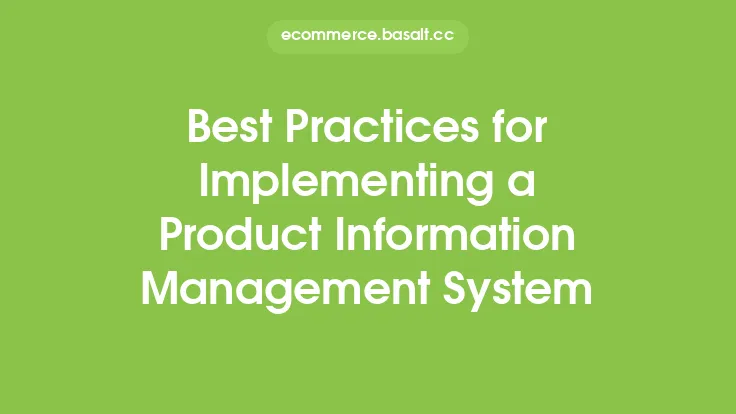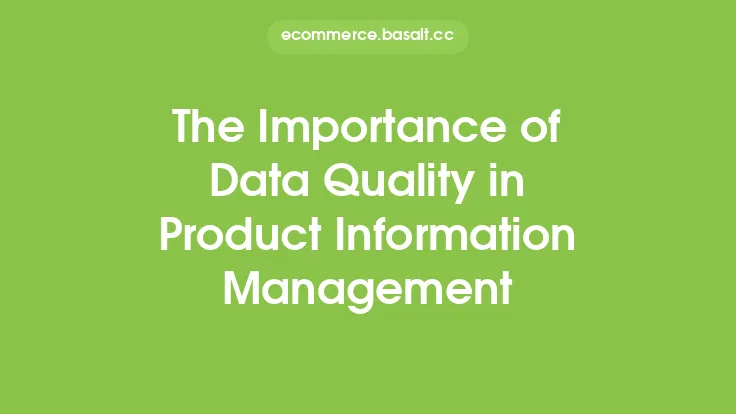Product Information Management (PIM) is a set of processes and tools that help businesses to centrally manage and maintain accurate, up-to-date, and consistent product information across all channels and touchpoints. It is a crucial aspect of e-commerce technology, as it enables companies to provide their customers with a seamless and informed shopping experience, regardless of whether they are browsing online, in-store, or through mobile devices.
Introduction to Product Information Management
PIM systems are designed to collect, store, and manage large amounts of product data, including descriptions, specifications, images, videos, and other digital assets. This data is then used to create a single, unified view of each product, which can be easily accessed and updated by authorized personnel. By having a centralized repository of product information, businesses can ensure that their product data is accurate, consistent, and readily available to all stakeholders, including customers, sales teams, and marketing departments.
How PIM Works
The PIM process typically involves several key steps, including data collection, data normalization, data enrichment, and data syndication. Data collection involves gathering product information from various sources, such as suppliers, manufacturers, and internal databases. Data normalization involves standardizing the collected data into a consistent format, making it easier to manage and analyze. Data enrichment involves adding additional information to the product data, such as images, videos, and customer reviews. Finally, data syndication involves distributing the product information to various channels, such as e-commerce websites, mobile apps, and social media platforms.
Components of a PIM System
A typical PIM system consists of several key components, including a product repository, a data management module, a workflow engine, and a syndication module. The product repository is the central database that stores all product information, while the data management module provides tools for collecting, normalizing, and enriching the data. The workflow engine enables businesses to automate and streamline their product information management processes, while the syndication module allows them to distribute their product information to various channels.
PIM Architecture
PIM systems can be implemented in a variety of architectures, including on-premise, cloud-based, and hybrid models. On-premise PIM systems are installed and managed locally, while cloud-based PIM systems are hosted and managed remotely. Hybrid models combine elements of both on-premise and cloud-based architectures, providing businesses with greater flexibility and scalability. Regardless of the architecture, PIM systems are designed to be highly scalable and flexible, allowing businesses to easily adapt to changing market conditions and customer needs.
Data Modeling in PIM
Data modeling is a critical aspect of PIM, as it involves creating a structured framework for organizing and managing product information. A well-designed data model enables businesses to create a single, unified view of each product, which can be easily accessed and updated by authorized personnel. Data modeling in PIM typically involves creating a set of entities, attributes, and relationships that define the structure and organization of the product data. This includes defining the types of product information that will be collected, such as descriptions, specifications, and images, as well as the relationships between different products and product categories.
Integration with Other Systems
PIM systems are often integrated with other e-commerce technologies, such as enterprise resource planning (ERP) systems, customer relationship management (CRM) systems, and e-commerce platforms. This integration enables businesses to create a seamless and connected customer experience, by providing a single, unified view of each product across all channels and touchpoints. Integration with other systems also enables businesses to automate and streamline their product information management processes, reducing the risk of errors and inconsistencies.
Security and Access Control
Security and access control are critical aspects of PIM, as they involve protecting sensitive product information from unauthorized access and ensuring that only authorized personnel can update and manage the data. PIM systems typically include a range of security features, such as user authentication, access control, and data encryption, to ensure that product information is protected and secure. Access control involves defining roles and permissions for different users, ensuring that only authorized personnel can access and update specific types of product information.
Conclusion
In conclusion, Product Information Management (PIM) is a critical aspect of e-commerce technology, enabling businesses to centrally manage and maintain accurate, up-to-date, and consistent product information across all channels and touchpoints. By understanding how PIM works, and the key components and architecture of a PIM system, businesses can create a seamless and informed shopping experience for their customers, while also improving their operational efficiency and reducing costs. Whether implemented on-premise, in the cloud, or in a hybrid model, PIM systems provide businesses with a powerful tool for managing their product information, and for creating a competitive advantage in the marketplace.





